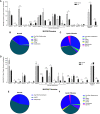Cystic Fibrosis Airway Mucus Hyperconcentration Produces a Vicious Cycle of Mucin, Pathogen, and Inflammatory Interactions that Promotes Disease Persistence
- PMID: 35486871
- PMCID: PMC9348562
- DOI: 10.1165/rcmb.2021-0359OC
Cystic Fibrosis Airway Mucus Hyperconcentration Produces a Vicious Cycle of Mucin, Pathogen, and Inflammatory Interactions that Promotes Disease Persistence
Abstract
The dynamics describing the vicious cycle characteristic of cystic fibrosis (CF) lung disease, initiated by stagnant mucus and perpetuated by infection and inflammation, remain unclear. Here we determine the effect of the CF airway milieu, with persistent mucoobstruction, resident pathogens, and inflammation, on the mucin quantity and quality that govern lung disease pathogenesis and progression. The concentrations of MUC5AC and MUC5B were measured and characterized in sputum samples from subjects with CF (N = 44) and healthy subjects (N = 29) with respect to their macromolecular properties, degree of proteolysis, and glycomics diversity. These parameters were related to quantitative microbiome and clinical data. MUC5AC and MUC5B concentrations were elevated, 30- and 8-fold, respectively, in CF as compared with control sputum. Mucin parameters did not correlate with hypertonic saline, inhaled corticosteroids, or antibiotics use. No differences in mucin parameters were detected at baseline versus during exacerbations. Mucin concentrations significantly correlated with the age and sputum human neutrophil elastase activity. Although significantly more proteolytic cleavages were detected in CF mucins, their macromolecular properties (e.g., size and molecular weight) were not significantly different than control mucins, likely reflecting the role of S-S bonds in maintaining multimeric structures. No evidence of giant mucin macromolecule reflecting oxidative stress-induced cross-linking was found. Mucin glycomic analysis revealed significantly more sialylated glycans in CF, and the total abundance of nonsulfated O-glycans correlated with the relative abundance of pathogens. Collectively, the interaction of mucins, pathogens, epithelium, and inflammatory cells promotes proteomic and glycomic changes that reflect a persistent mucoobstructive, infectious, and inflammatory state.
Keywords: cystic fibrosis; inflammation; microbiome; mucins; mucus obstruction.
Figures







Comment in
-
Infection and Inflammation MUC up the Cystic Fibrosis Airway.Am J Respir Cell Mol Biol. 2022 Aug;67(2):153-154. doi: 10.1165/rcmb.2022-0182ED. Am J Respir Cell Mol Biol. 2022. PMID: 35585759 Free PMC article. No abstract available.
References
-
- Riordan JR, Rommens JM, Kerem B, Alon N, Rozmahel R, Grzelczak Z, et al. Identification of the cystic fibrosis gene: cloning and characterization of complementary DNA. Science . 1989;245:1066–1073. - PubMed
-
- Boucher RC. Airway surface dehydration in cystic fibrosis: pathogenesis and therapy. Annu Rev Med . 2007;58:157–170. - PubMed
-
- Thornton DJ, Rousseau K, McGuckin MA. Structure and function of the polymeric mucins in airways mucus. Annu Rev Physiol . 2008;70:459–486. - PubMed
Publication types
MeSH terms
Substances
Grants and funding
LinkOut - more resources
Full Text Sources
Medical

